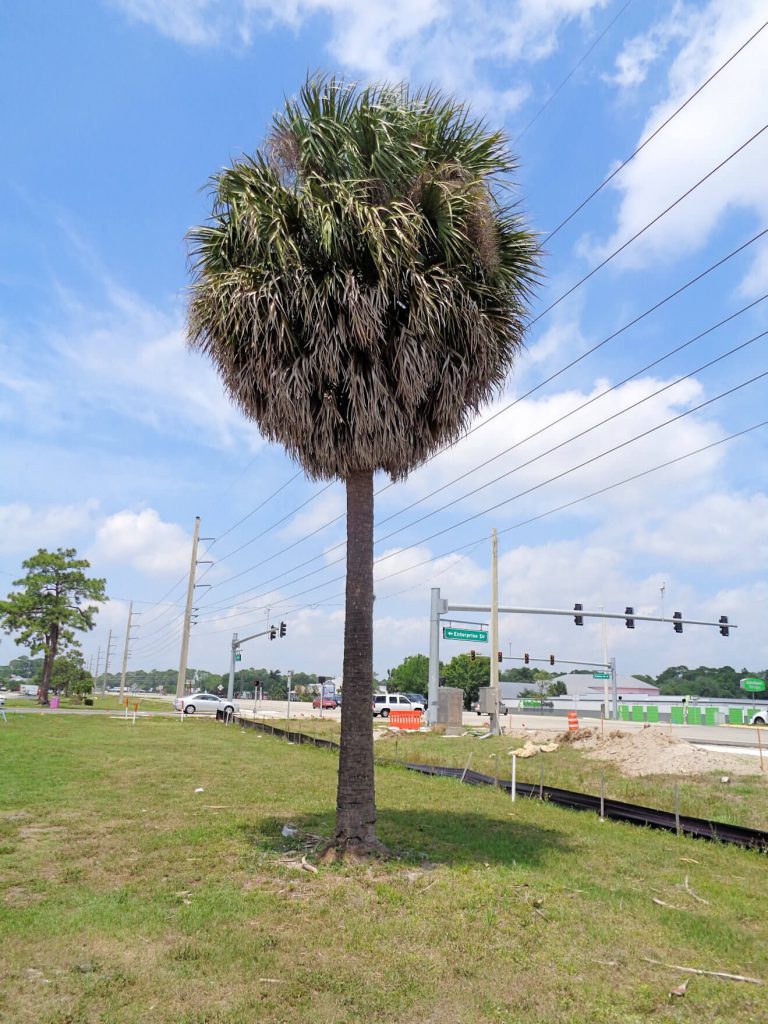By Ralph E. Mitchell
 I seldom see a Sabal palm in our area that is not over-pruned. You have to give a pass to newly planted Sabals which look like lifeless sticks – this is the normal and best way to transplant them! But to see a Sabal specimen look like it should look like – a giant lollipop of sorts – is a real eye-catcher. I saw one off of 41 in Port Charlotte the other day – the one I have been looking for – the lollipop! This Sabal had a full canopy without excess pruning the way nature meant these majestic plants to look like!
I seldom see a Sabal palm in our area that is not over-pruned. You have to give a pass to newly planted Sabals which look like lifeless sticks – this is the normal and best way to transplant them! But to see a Sabal specimen look like it should look like – a giant lollipop of sorts – is a real eye-catcher. I saw one off of 41 in Port Charlotte the other day – the one I have been looking for – the lollipop! This Sabal had a full canopy without excess pruning the way nature meant these majestic plants to look like!
Sabal palms are all around you and hard to miss. This native palm – our State “tree” – takes a licking through hurricanes and over-zealous pruners to decorate our highways and byways. Sabal palms take the cold and the heat and salt spray to a degree. They also provide us with the local delicacy called “swamp cabbage” which is a delicious and rare treat. Their small white flowers provide sustenance for bees, and raccoons eat the resulting fruit. Seeds are easy to germinate but will take up to thirty years for a trunk to develop under natural conditions. Early trunk growth can speed up to six-inches per year, but slows to barely an inch per year as the Sabal matures. You can just imagine how old some of these palms are!
In the landscape, Sabals are preserved on site or transplanted from other sources. Generally, Sabals may be taken from pastures or land clearing operations and prepared for installation elsewhere. Mature Sabal palms are unusual as they can regenerate all new roots after the old cut ones die back. Only palms with trunks at least ten feet long have sufficient resources to see them though the eight month or longer establishment period. Most, if not all, of the fronds are removed on transplants. Studies have shown that removing all of the leaves at transplanting resulted in a ninety-five percent survival rate. Commercial nurseries may also establish Sabal palms in large pots where they are then ready-for-transplanting with minimal transplant shock.
Many people ask about the leaf bases or so-called “boots” that can remain on the trunk. Some Sabal palms retain these ten or more years, some shed them more rapidly – this appears to be genetic. Both leaf base patterned, and clean trunks are equally attractive and are likely an individual trait. Prune carefully removing only brown fronds and flowering stalks. Try not to remove any green fronds if at all possible. For sure – no “hurricane cuts”! “Hurricane cuts” do not make the palm more hurricane resistant (actually less), removes the palms ability to make and store food, is not a proper arboricultural technique, and is actually against a County code.
While Sabal palms in nature seem to do fine with the nutrients they obtain in the wild, transplanted residential Sabals may benefit from a regular feeding to ward off nutritional deficiencies. If you are not already doing so, apply a granular fertilizer formulation – 8-2-12-4 (or 8-0-12-4) in November, February and May as per label directions. In August use a 0-0-16-6, again as per label directions.
Sabal palms are tough survivors which rarely have pest issues. One exception may be a recent disease called Lethal Bronzing which is in our area and can infect Sabal palms. Please feel free to contact our office about this disease if you have any questions or concerns.
Sabal palms are abundant both in natural areas and in our urban forests. They may not hold the same elegance as our fancy cultivated exotic palms, but everybody who sees them appreciates their resilience and humble longevity. Take the “lollipop” on 41, a lone palm, but one of the nicest in our fair Port Charlotte! For more information on all types of palms suitable for planting in our area, please visit https://www.facebook.com/CharlotteMGLifeline/. Ralph E. Mitchell is the Director/Horticulture Agent for the UF/IFAS Charlotte County Extension Service. He can be reached at 941-764-4344 or ralph.mitchell@charlottecountyfl.gov.
Resource:
Broschat, T. K. (2017) Sabal palmetto: Sabal or Cabbage Palm. The University of Florida Extension Service, IFAS.
 1
1
